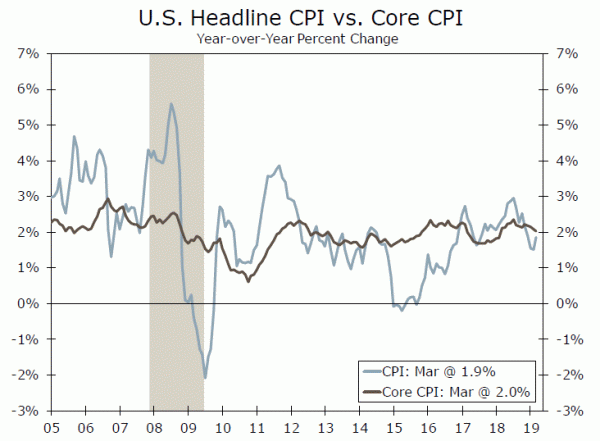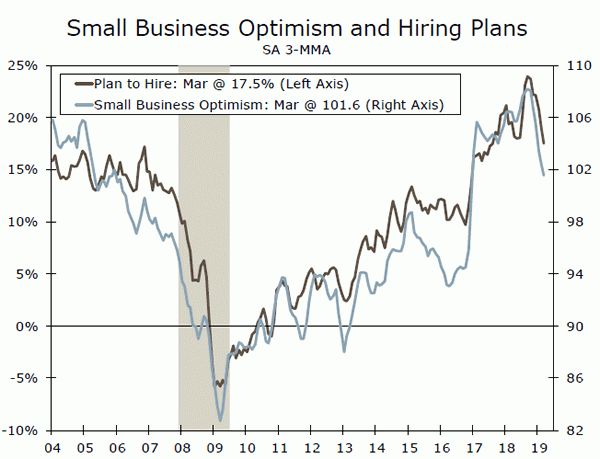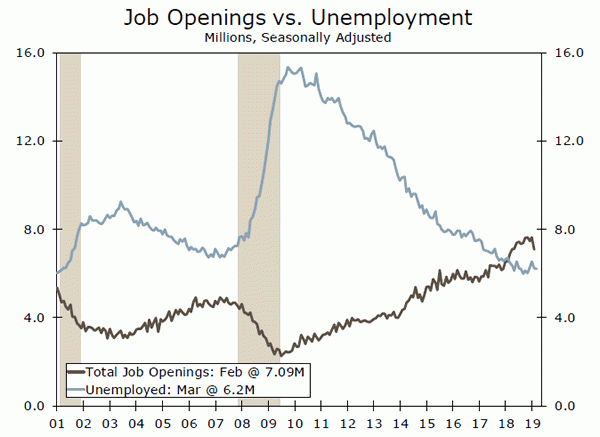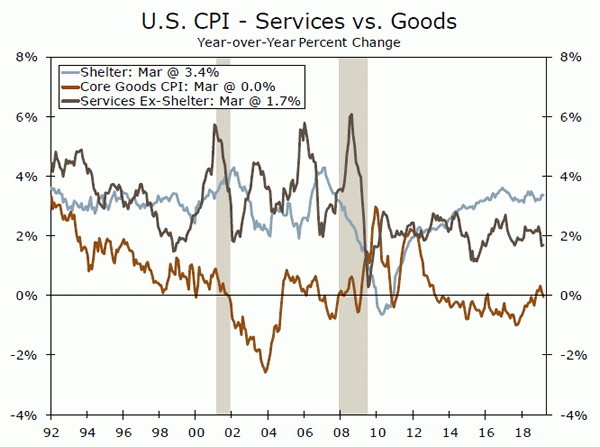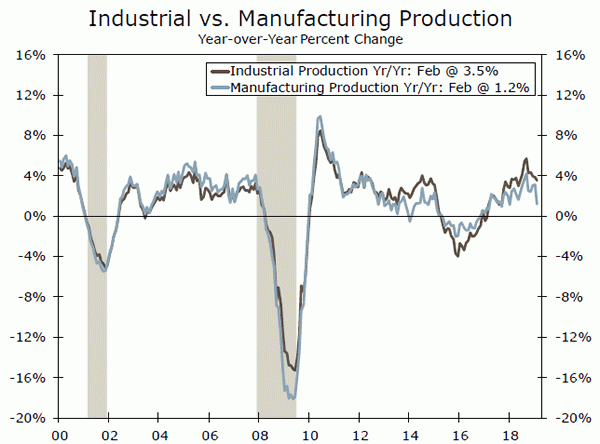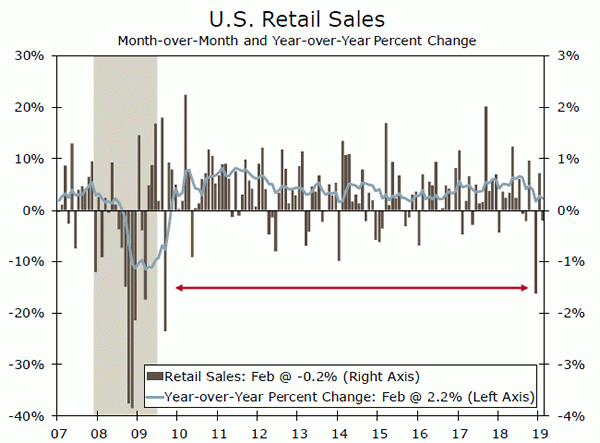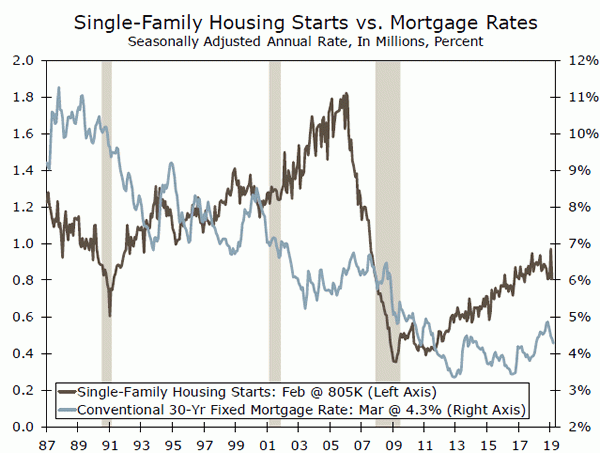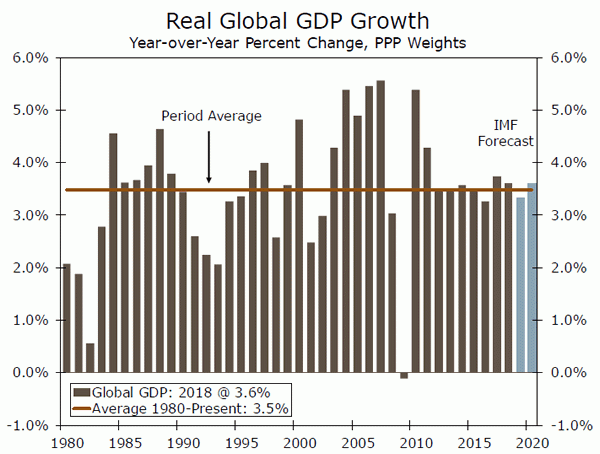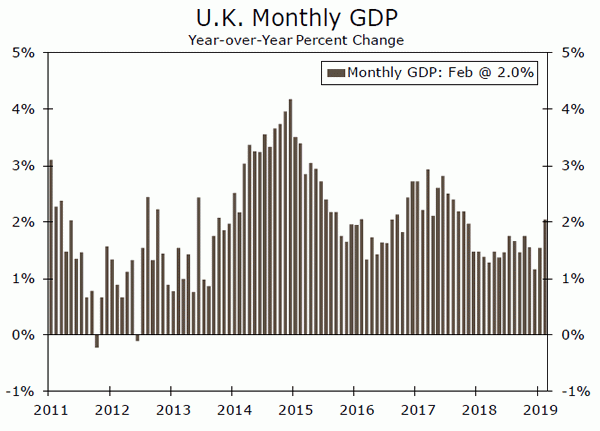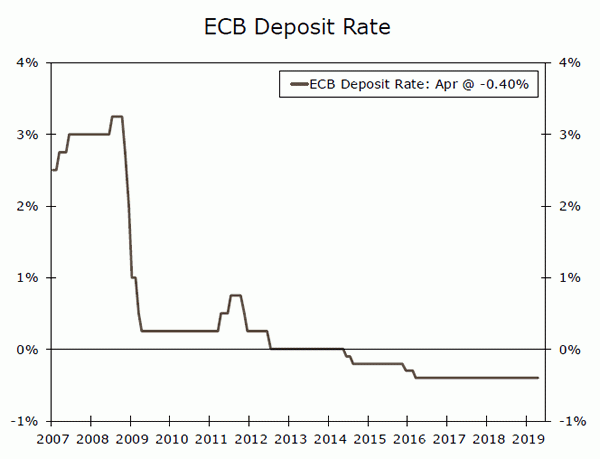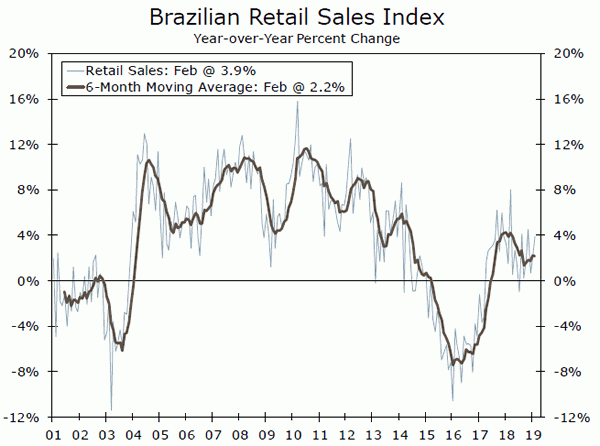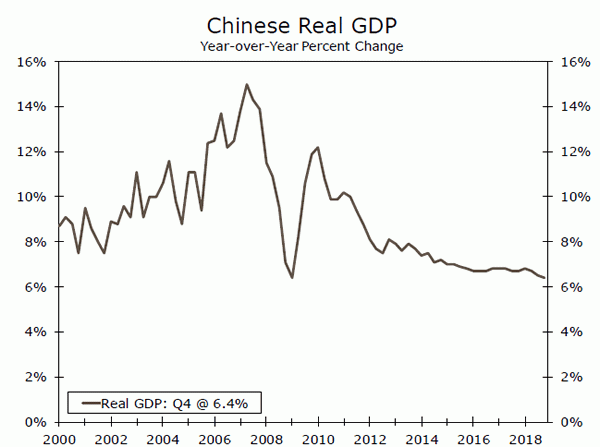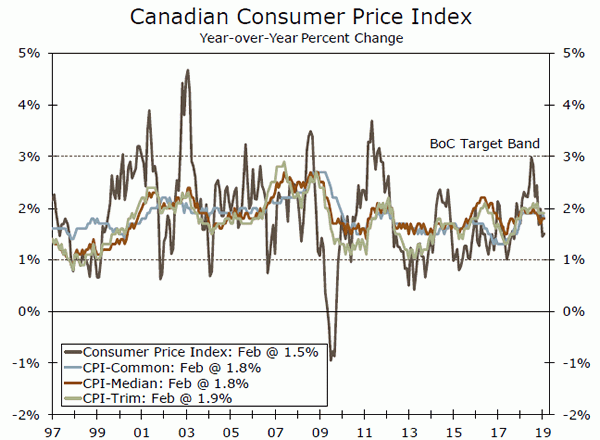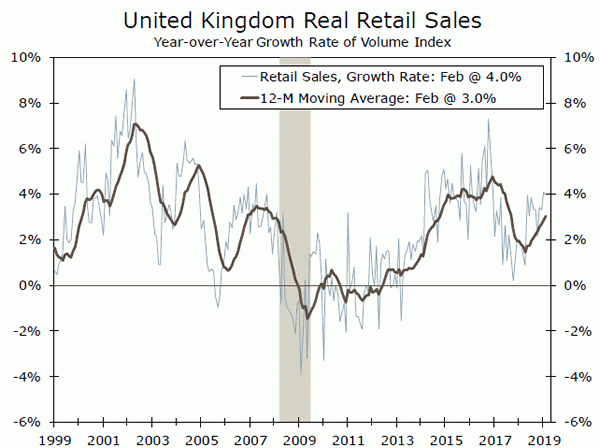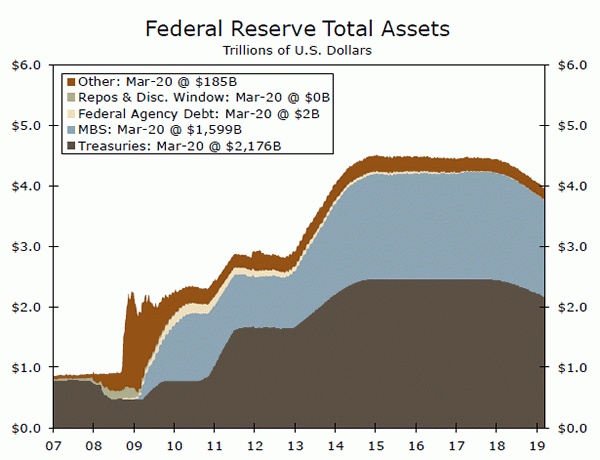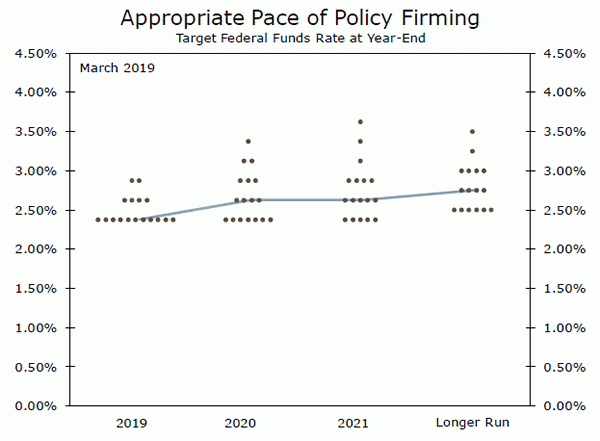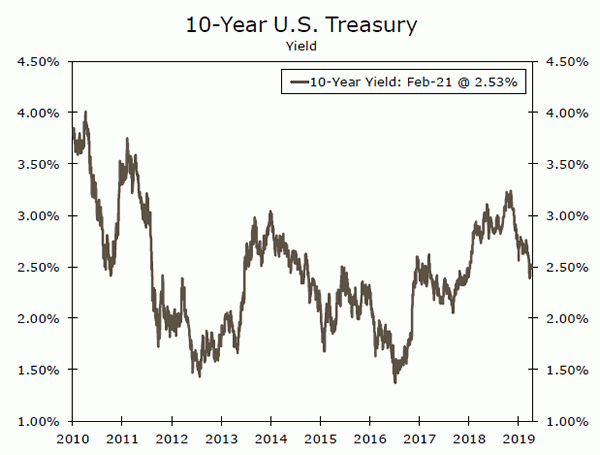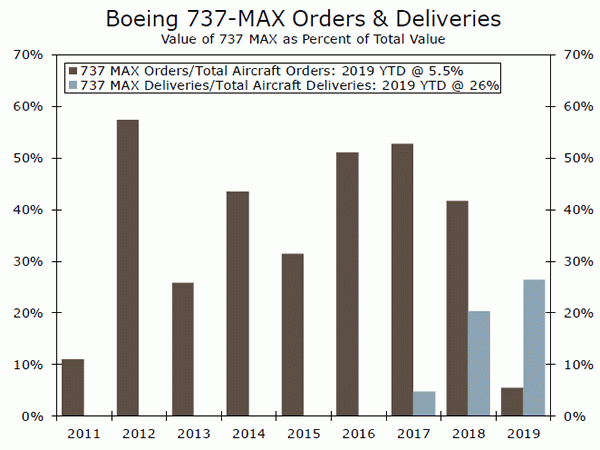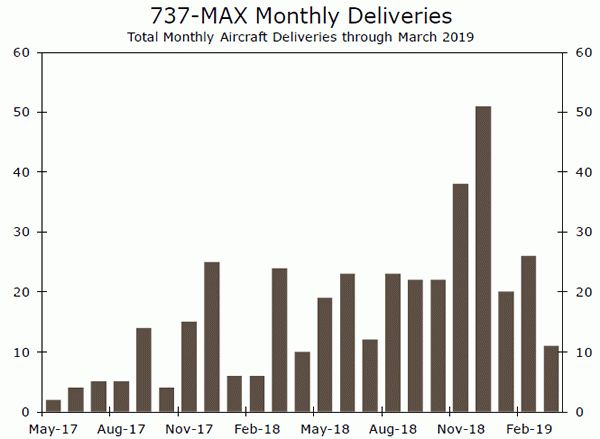U.S. Review
No Need for the Fed to Budge
- Inflation picked up in March, with the CPI rising 0.4% and strengthening to 1.9% yr/yr. The trend in inflation remains tame, however, with consumer prices ex-food and energy edging down to 2.0% on a year-ago basis.
- Small business optimism was little changed in March and remains noticeably below last year’s levels.
- Job openings fell sharply in February, while initial jobless claims fell to a new cycle low the first week of April. The late timing of Easter may be holding down the latest claims data, leading us to believe that the overall pace of hiring is likely to remain slower than last year.
No Need for the Fed to Budge
Incoming data this week showed that U.S. growth continues to hold up, although it is unlikely to be on the brink of a significant reacceleration. Inflation remains near 2%, while the pace of the labor market’s improvement is easing on balance. Together, nothing this week suggested that the Fed may need to adjust its “patient” policy stance any time soon.
Small business optimism was virtually unchanged in March. Despite the stock market having recovered from its end-of-year rough patch and the government shutdown now firmly in the rearview mirror, the index remains noticeably below the current cycle’s high reached in August. The lack of a rebound suggests that small businesses are feeling the economy’s recent slowdown. Small businesses’ expectations for sales have come down since the fourth quarter, and fewer respondents indicate now is a good time to expand.
Hiring plans have come down as a result, although difficulty finding workers in such a tight labor market may on its own be reducing expansion plans. The availability of quality labor remains the most frequently cited problem among small businesses. Even as hiring plans have been pared back, a record share of firms report having at least one job that is hard to fill.
Other data released this week also suggest the labor market remains tight, but point to a more moderate pace of hiring ahead. Total job openings continue to outnumber unemployed workers, but the vacancy rate fell to a one-year low in February. Job openings can bounce around from month to month and are subject to big revisions, so the 538K drop in openings in February does not unequivocally signal a collapse in demand for workers. It does, however, offer another sign that the labor market may be nearing an inflection point, as temporary hiring has also slowed and consumers’ views of the labor market have deteriorated slightly.
Jobless claims have been better in recent weeks, with initial filings falling to a 50-year. The late timing of Easter this year may be flattering the recent figures, but the multi-decade low suggests at least that the slowdown in hiring is likely to be only modest.
At the same time there are tentative signs of the labor market softening, consumers are also facing a bit more inflation. The consumer price index rose 0.4% in March, its largest gain in more than a year. Higher prices at the gas pump were partly to blame, but consumers also saw their grocery bills increase. Consumer price inflation is rising again on a year-ago basis and contributing to slower growth in real wages.
The overall trend in inflation, however, remains tame. A soft gain in March core inflation pushed core CPI down to 2.0% yr/yr. Prices for core goods are falling again, although the 0.2% drop in March looks to have been depressed by a BLS new data collection procedure. Services inflation continues to hold up better. Shelter costs rose strongly again in March, while services inflation exshelter remains within its recent band. With inflation expectations in check and growth slowing back to trend, we see little risk of inflation moving meaningfully above 2% this year.
U.S. Outlook
Industrial Production • Tuesday
Manufacturing has lost momentum this year, as the global slowdown and trade headwinds are becoming more evident in the sector. Manufacturers shed 6,000 jobs in March—the first cut in a little over a year and a half. The decline in employment and mixed PMI readings for the month suggest it is unlikely we will see a manufacturing rebound in Tuesday’s industrial production release.
Production elsewhere will likely be mixed. The unseasonably cold weather across the nation in March likely boosted utilities output again that month. But the decline in average hours worked in the mining sector may hold back a significant gain in mining output.
We expect to see a slight bounce in March, but production growth has downshifted. The ISM index is lower on trend in recent months and durable goods orders through February suggest equipment spending is set for a weak outturn in the first quarter.
Previous: 0.1% Wells Fargo: 0.2% Consensus: 0.2% (Month-over-Month)
Retail Sales • Wednesday
In what has been a wonky few months for consumer data, we expect retail sales to have regained some steady footing in March. The 1.6% drop in December sales caused nominal spending on goods to enter the first quarter on a weak note. Sales continued to struggle at the start of this year—rebounding 0.7% in January, but edging down 0.2% in February.
Underlying fundamentals remain supportive of strong growth in spending. The labor market is robust, household balance sheets are in generally good shape and indices of consumer confidence remain at high levels.
On that basis, we look for retail sales to have risen 0.9% in March. If sales disappoint again, however, economic growth will likely be weaker than the 1.8% annualized rate we have penciled in for the first quarter.
Previous: -0.2% Wells Fargo: 0.9% Consensus: 0.9% (Month-over-Month)
Housing Starts • Friday
Fear that the Fed would continue to hike interest rates led to a weak outturn for housing activity at the end of last year. Affordability concerns deterred potential buyers from making a purchase, and builders slashed home prices to shed inventories. With decreased demand and an uncertain outlook, starts weakened.
The Fed’s pivot on monetary policy appears to have arrested the slide in housing starts but has not reversed it. Home prices and mortgage rates have both trended lower and remain below their year-ago levels. Mortgage applications surged in March, suggesting the cooling in prices is driving greater demand, while builder confidence has also rebounded from last year’s lows.
We should see a modest increase in March housing starts, as recent conditions suggest a more upbeat housing market headed into the spring selling season.
Previous: 1,162K Wells Fargo: 1,228K Consensus: 1,230K
Global Review
Global Growth: Take the Good with the Bad
- The past week has been a mixed bag on the global front, but one which might be considered an improvement considering the pervasive pessimism that has prevailed in recent weeks.
- Starting on a subdued note, the IMF cut its 2019 GDP growth forecast to 3.3%, which would be the slowest growth since 2016.
- The U.K news was better, with February services and industrial activity both rising, although an extension to the U.K.’s Brexit deadline could still growth slow going forward. Eurozone industrial output was also less bad than feared, and potentially consistent with an increase in Q1 industrial activity.
The U.K.’s Brexit Saga Continues
It has been another week and another missed deadline for U.K. politicians as they try to map out a path for the U.K.’s exit from the European Union. In early April, U.K. PM May’s Brexit proposal was defeated in Parliament for a third time. At the same time, Parliament has been unable to garner a majority for an alternative course of action, while talks between May and opposition leader Jeremy Corbyn have not led to any breakthrough. Without a credible U.K. path forward, the other 27 European Union countries granted the U.K an extension of the Article 50 deadline until October 31. While that might be a short term positive in that it removes the immediate risk of a no-deal Brexit, it is potentially a longer-term negative given that uncertainty about the U.K.’s future relationship with the other European Union countries will persist.
The early part of 2019 has been notable for relativity resilient growth, even against this backdrop of Brexit uncertainty. U.K. February GDP rose 0.2% month-over-month, a solid result on the back of a 0.5% gain in January. Service sector output rose 0.1%, while industrial production rose 0.6%. That said, there are signs from the survey data that part of the early 2019 growth reflects stockpiling of inventories. Especially in the context of a long Brexit extension and the resultant and ongoing uncertainty, the pace of U.K. economic growth is likely to slow going forward.
ECB Steady in April
After a significant policy shift at its March monetary policy meeting, the European Central Bank’s April announcement was a much tamer affair. The ECB held its policy interest rates steady and made no changes to its forward guidance, saying that interest rates would remain at their present low levels at least through the end of this year. The ECB also provided no extra details—for now— surrounding its new round of targeted long-term loans, and said that the risks around the Eurozone growth outlook remain tilted towards the downside.
Since the ECB’s March meeting there have been some tentative signs of growth stabilization. The Eurozone services PMI rose in March, although the manufacturing PMI remains in contraction territory. That said, even though Eurozone industrial production fell 0.2% month-over-month in February, industrial activity for the first two months of the year is up 0.8% compared to its Q4 level.
Modestly Positive News From Latin America
The past week saw some mildly encouraging news from Latin America, although the region’s economies still face longer term challenges. Brazil’s February retail sales firmed more than forecast to 3.9% year-over-year, services activity rose 3.8% and the March CPI also quickened to 4.6% year-over-year. In Mexico, January fixed investment rose 1.6% year-over-year but February industrial production fell 0.8%, while March CPI inflation was well behaved, edging higher to 4.0%. In Brazil, longer term growth prospects remain heavily dependent on pension reform and fiscal consolidation, while in Mexico policy uncertainty remains a potential medium-term growth negative.
Global Outlook
China GDP • Wednesday
China rounds out its first quarter figures with the release of a comprehensive set of activity data in the coming week. Overall, we expect GDP growth may have held steady at 6.4% year-over-year, although the consensus sees a further slowing to 6.3%. Generally, service sector growth has held up better than manufacturing growth, a trend we think likely continued in the first quarter.
In addition to assessing the extent of the overall Q1 slowdown, there will also be much interest in whether there are any signs of stabilization in activity, hinted at by some encouraging readings for the March manufacturing and services PMIs. The consensus forecast is that these “soft signals” could translate over to the hard data. March retail sales are expected to rise 8.4% year-over-year, while industrial production is expected to rise by 6.0%—both outcomes would be stronger than the gains reported for the January-February period.
Previous: 6.4% Wells Fargo: 6.4% Consensus: 6.3% (Year-over-Year)
Canada CPI • Wednesday
Canadian inflation trends have been benign in recent months and probably remained so in March, suggesting the Bank of Canada will likely keep policy interest rates steady for some time. The headline CPI should quicken to 1.8% year-over-year, as a recovery in oil prices in recent months should be reflected in energy prices and overall CPI trends. Services prices remained contained however, while the central bank core CPI inflation measures should remain modestly below the 2% inflation target.
Next week’s activity data and confidence surveys are also unlikely to offer much reason for the Bank of Canada to contemplate a change in interest rates for now, with February retail sales among the more notable data releases. The Bank of Canada’s Q1 Business Outlook Survey is also released—analysts will watch for an improvement in the future sales balance, after that index fell to -1 in Q4-2018.
Previous: 1.5% Wells Fargo: 1.8% (Year-over-Year)
U.K. Retail Sales • Thursday
Despite the Brexit uncertainty that continues to hang over the U.K. economy, growth has remained reasonably solid during the early part of 2019. While that may in part be due to inventory stockpiling ahead of the U.K.’s eventual exit from the European Union, we note that consumer spending trends have been quite steady in the early part of this year. After increases in both January and February, the consensus expects some payback, with retail sales forecast to decline 0.3% month-over-month in March. That said, overall gains in retail sales and industrial production in recent months mean we think that Q1 GDP is on track for growth of 0.5% quarter-over-quarter.
Next week we also see the release of price and wage data. Inflation likely remain benign in March, with the CPI expected to rise 2.0% year-over-year and the core CPI expected to rise 1.9%. Look for wage trends to remain sturdy, with average weekly earnings expected to rise 3.5% year-over-year in the three months through February.
Previous: 0.4% Consensus: -0.3% (Month-over-Month)
Point of View
Interest Rate Watch
Minutes Show Fed to Remain on Hold
The minutes of the March 20 meeting of the Federal Open Market Committee (FOMC) were released this week. That meeting was notable because the “dot plot” that was released at the conclusion of the meeting showed that most committee members thought that rates would be on hold through the end of the year. (In December, the dot plot indicated that most FOMC members thought that rates would be at least 50 bps higher at the end of 2019.) In addition, the FOMC decided at its March 20 meeting on concrete steps to bring the shrinking of the Fed’s balance sheet, which currently stands at $3.9 trillion, to an end in September 2019 (top chart).
The minutes of the March 20 meeting made it clear that the committee is in no hurry to raise the fed funds rate from its current range of 2.25% to 2.50%, at least not for the foreseeable future. However, none of the 17 committee members who attended the March 20 meeting projected that the range for the fed funds rate would be lower at the end of 2019 than it is now (middle chart). The minutes said that the committee believes that sustained economic expansion, continued strength in the labor market and inflation near the FOMC’s objective of 2% are “the most likely outcomes for the U.S. economy in the period ahead.” In our view, incoming economic data would need to show that 2019 real GDP growth will undershoot the 2.1% rate (Q4/Q4) that the FOMC currently projects and/or inflation will come in significantly lower than the 2% objective for the committee to cut rates in coming months.
Pricing in the bond market at present shows that market participants believe there is a one-in-three chance that the Fed cuts rates by the September FOMC meeting. That probability rises to a bit more than 50% by the December policy meeting. If our view that the FOMC will remain in hold throughout 2019 is correct, then the back end of the yield curve should rise as the market prices out the expected rate cut. As we write, the yield on the 10-year Treasury security is roughly 2.54% (bottom chart). We look for this yield to drift up to 2.70% by the end of the year.
Credit Market Insights
Consumer Credit Growth Stabilizes
U.S. consumer debt growth eased in February to $15.2B from $17.7B, below market expectations. Revolving credit including credit card borrowing reached a new high of $1.06T, climbing $3B from the previous month. Non-revolving credit, which includes educational loans and automobiles, increased only $12.2B, after rising $15.1B in January.
The data suggest that consumer borrowing remains strong due to higher wages and job growth. Household debt ticked up in the fourth quarter of 2018, with mortgage balances almost unchanged from the previous quarter. The total amount of outstanding student loans increased $15B over the fourth quarter, reaching $1.46T. Student loan debt is now the second highest consumer debt category, behind mortgage debt, with over 44 million borrowers of all demographics and age groups. 11.4% of aggregate student debt was 90+ days delinquent in Q4-2018, a slight improvement from the previous quarter. The growth in student loan debt remains a concern among analysts, as it represents one of the country’s most widespread financial burdens.
On balance, household balance sheets remain generally healthy and consumer fundamentals remain strong. That is, despite the recent soft patch in consumer spending, consumer confidence remains high. As we expect the first quarter lull in consumption is only temporary we do not see a large pull-back in borrowing.
Topic of the Week
The MAX Impact of Boeing’s 737 Problem
Boeing’s cut to production of the 737 line of aircraft is not an all-out stop but rather a scaling back by about 20% of its earlier production rate. Still, the production cuts are expected to hold down GDP slightly, while the grounding of the 737-MAX is expected to generate bigger waves for equipment spending, exports and inventories over the remainder of the year.
Prior to scaling back, Boeing stated it was planning to produce 52 737 aircraft per month, and the 737 MAX model was expected to account for roughly 90% of 737 deliveries in 2019. Boeing expected to raise production to 57 aircraft per month in June 2019. The production cuts take that figure down to 42 aircrafts per month by mid-April. At an annualized pace, adjusted for inflation, the decreased production is expected to subtract about $9 billion from output in the second quarter, or shave about 0.2 percentage points from Q2 GDP growth. If, as we expect, Boeing provides a fix to the 737 MAX system and production ramps back up in the third quarter, a catch-up boost of a similar magnitude would occur.
In the meantime, the current halt in deliveries is expected to weigh on equipment spending and exports. Without receipt of the aircraft and corresponding payment, purchases that were expected in the second quarter by U.S. and foreign buyers are to be postponed. Inventories are set to pile up, however, which should largely offset the near-term drop in spending and keep the impact to topline GDP minimal.
The precise impact to GDP will depend on how long Boeing produces the 737 at the lower rate and how long it takes various aviation authorities around the world to give the 737-MAX the all-clear to resume flying. Our modeling of the economic impact suggests that Q2 GDP growth will be held back but a catch-up boost will materialize either in the third quarter or over subsequent quarters, depending on how long it takes for the backlog in shipments to run its course.




